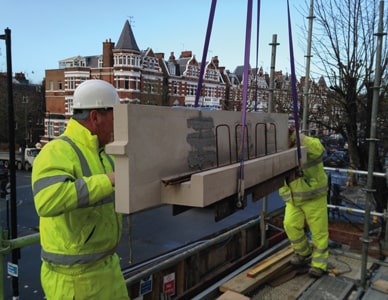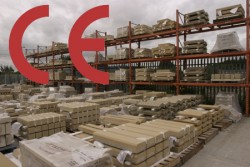CE Marking Cast Stone Explained, Plus Which Standards Apply
Our Director of Procter Cast Stone explains under what circumstances CE Marking cast stone products to the EU Construction Products Regulation is mandatory, and when it would not be legal to do so. This technical article also discusses the related matter of the different standards that should be applied when manufacturing cast stone.
Following an extensive consultation process, there is now industry consensus on the circumstances under which cast stone products should be CE marked in accordance with the EU Construction Products Regulation 305/2011 (CPR), which came into force on 1 July 2013 to replace the Construction Products Directive (CPD). Now that guidance documents have been published containing tables and a checklist there is, at last, clarity for architects, specifiers, manufacturers, suppliers and contractors. Prior to this there was confusion and conflicting advice, so all parties will welcome the new, easily understood guidelines.
One of the problems behind the previous confusion is that the CPR was developed by the European Commission and therefore refers to European standards including EN 771-5 (Specification for masonry units. Manufactured stone masonry units), of which BS EN 771-5:2011 is the current edition of the equivalent ‘transposed’ British Standard published by BSI. However, BSI also publishes BS 1217:2008 (Cast stone. Specification), which is the standard followed by most UK manufacturers of cast stone – though the Specification for Cast Stone published by UKCSA, and which UKCSA members adhere to, is more stringent than BS 1217.
For completeness, we should also mention both parts of British Standard BS 5642, namely BS 5642-1 (Sills, copings and cappings. Specification for window sills of precast concrete, cast stone, clayware, slate and natural stone) and BS 5642-2 (Sills, copings and cappings. Specification for copings and cappings of precast concrete, cast stone, clayware, slate and natural stone). Because there was a potential conflict between BS 5642 and BS 1217, BSI issued amendments in February 2014 to the effect that cast stone sills, copings and cappings shall be manufactured in accordance with BS 1217 (see here for more information about Cast Stone British Standards).
The situation now is that various factors influence which standard applies (BS 1217 or BS EN 771-5), and if CE marking the cast stone product is necessary. These factors are: whether any dimension exceeds 650mm; whether reinforcement or fixings are incorporated; whether the product is standard or bespoke; and whether the product is a standard-sized ashlar walling block.
One of the documents produced by UKCSA is a checklist structured as a decision tree so users simply answer ‘yes’ or ‘no’ to a series of straightforward questions. This leads the way through the decision process for identifying whether or not to CE mark the cast stone. However, in some circumstances ‘derogation’ is an option for the manufacturer. This means the manufacturer has the choice of whether or not to CE mark a bespoke product when it is manufactured in a ‘non-series’ production process, with various criteria influencing whether the production is ‘series’ or ‘non-series’ (eg quantities, differences between units, and production methods). More information is provided in the European Commission’s document CPR 07/07/01, Explanations on Art 5(a) of the CPR, but an important point to note is that CPR 07/07/01 includes the following statement: a “non-series process” should be understood as the manufacture of goods in small quantities without using standardised designs and assembly line techniques.
Let us consider a few different situations and what the requirements would be in each case.
A cast stone quoin manufactured to replace a damaged quarried stone item on a refurbishment project. No reinforcement or fixings incorporated.
In this case the maximum dimension is less than 650mm and, because it is being manufactured to replicate a quoin on an old building, it is a non-standard design produced to the architect’s drawings and specifications. The UKCSA CE Marking Checklist indicates that derogation is available, so the manufacturer can decide whether or not to CE mark the one-off cast stone product. Looking at the EC’s document CPR 07/07/01, it is clear that this product is classed as being manufactured in a ‘non-series process’ (small quantities without using standardised designs and assembly line techniques), so CE marking this cast stone product is not required.
Standard ashlar walling blocks of a standard size either manufactured for stock or to order.
Standard ashlar walling blocks are the only products that must be manufactured to BS EN 771-5 and CE marked to the CPR, regardless of whether they are being manufactured for stock or to fulfil a specific order.
A non-standard, single-piece sill 850mm long with reinforcement and fixings.
Because this cill is longer than 650mm, it falls outside the scope of CE marking to the CPR. In this case the product must be manufactured to BS 1217 and, if the manufacturer is a member of UKCSA, the sill must also be manufactured in accordance with the UKCSA Specification for Cast Stone.
Compared with the confusion that reigned previously, the new UKCSA guidelines make it very straightforward to decide whether or not CE marking cast stone is legally required or if derogation is available as an option. The guidance also identifies which standards should be applied. Nevertheless, if architects, specifiers or contractors have any questions, they are welcome to contact the technical experts at Procter Cast Stone for advice and guidance. Furthermore, the two UKCSA documents, together with a wealth of other free guides and technical information, are available to download from the Procter Cast Stone website.
Follow the link to download the CE Marking cast stone guides or other documents, and use the Live Chat facility to ask for more information or discuss specific projects.




